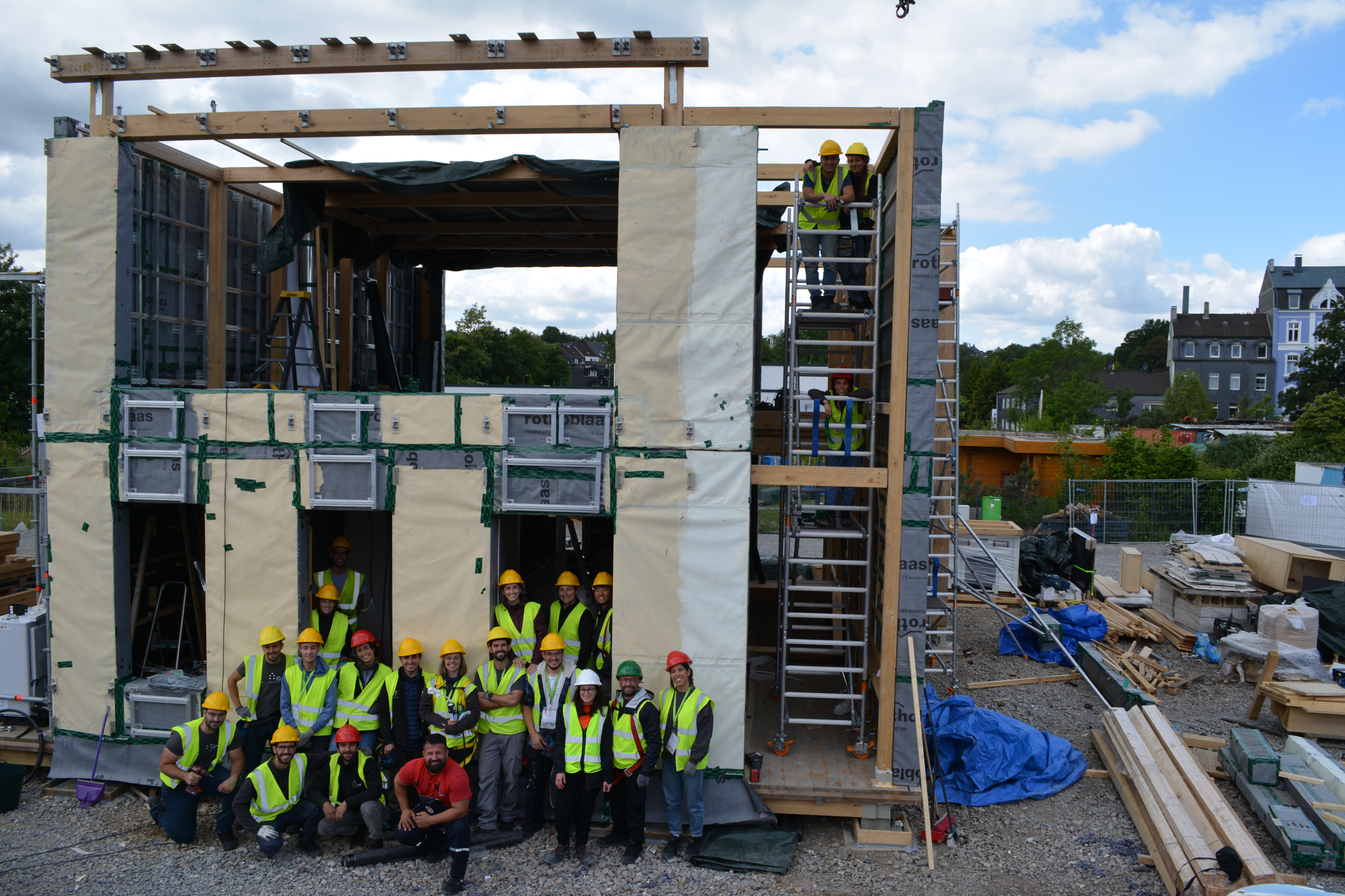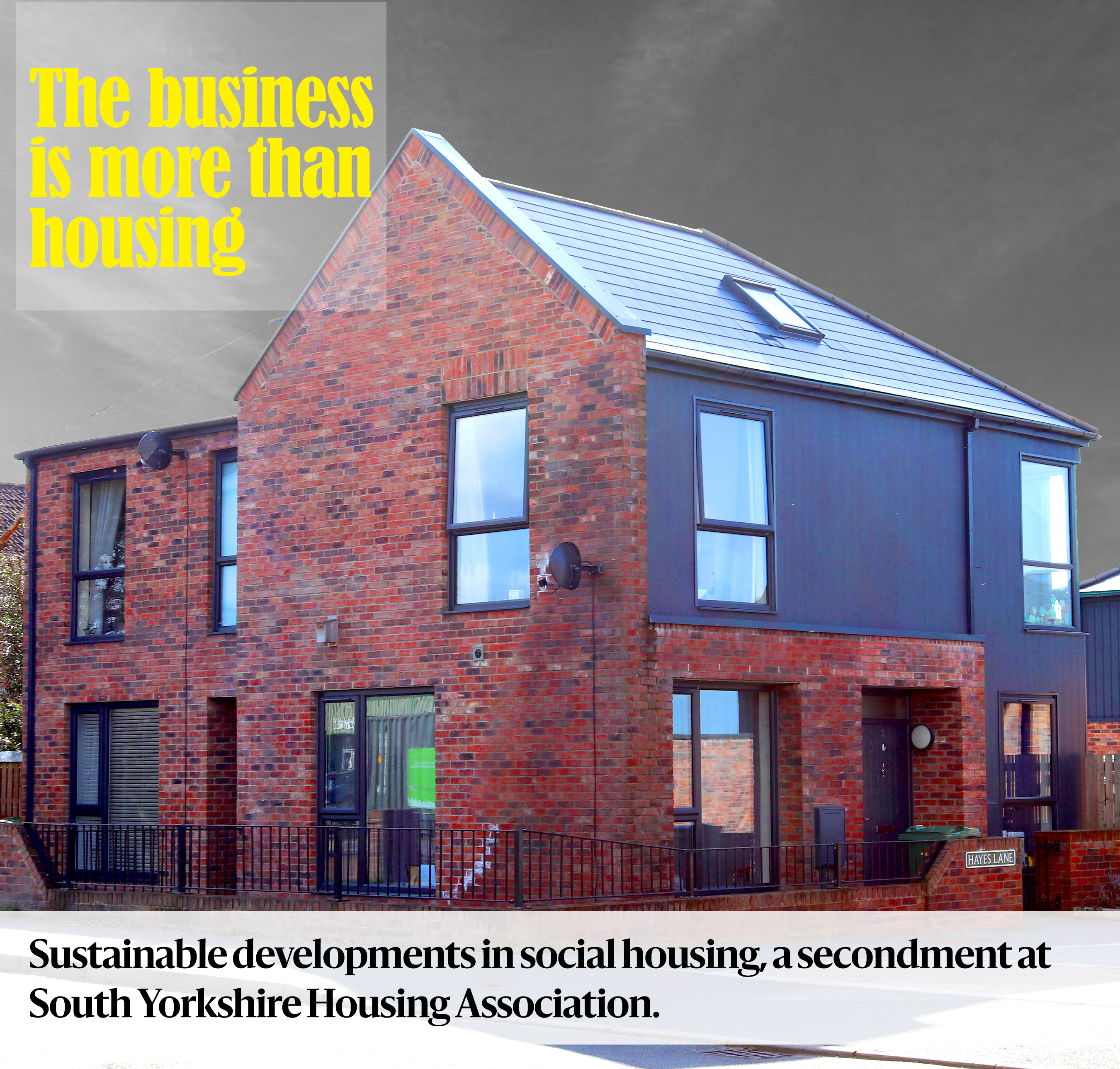WikiHouse: South Yorkshire Housing Association
Created on 19-06-2024 | Updated on 16-10-2024
WikiHouse is an open-source building system developed in the UK, utilising industrialised construction and off-site methods to provide high-performance, low-carbon, circular housing. The system, which is based on standardised lightweight timber products connected using dry construction, incorporates design for disassembly to facilitate future adaptability, maintenance, and reuse. WikiHouses are composed of components designed to be digitally fabricated using a CNC machine. This makes it accessible to a wide range of users, from lay-persons all the way up to large-scale housing providers such as South Yorkshire Housing Association (SYHA), who are also a RE-DWELL partner. In 2018, SYHA was the first housing association to implement WikiHouse, aiming to take advantage of the system to address the UK’s pressing housing crisis, where the government has set a target of providing 300,000 new homes each year. WikiHouse stood out as an attractive solution for SYHA, given its potential to produce high-quality homes in shorter time scales and its possibilities for residents to participate in the design process. The pilot project tested the viability of WikiHouse for SYHA’s rental portfolio, focussing on cost-efficiency, environmental performance, and scalability. Despite challenges such as unexpected ground condition issues and building warranty hurdles, the project provided valuable insights. Residents praised the homes for their warmth and low energy bills, and SYHA found the WikiHouse's assembly process efficient once initial learning curves were overcome.
This case study is based on an interview with Miranda Plowden, SYHA’s former Business Development Director who was involved in the delivery of the WikiHouse pilot.
Architect(s)
Open Systems Lab - Alastair Parvin; Architecture 00 – Clayton Prest, David Saxby
Location
Sheffield, UK
Project (year)
2017-2018
Construction (year)
2018
Housing type
Two semi-detached homes (2 storeys)
Urban context
Close to Sheffield city centre
Construction system
Open source prefabricated ‘modular’ system using a plywood timber structure
Status
Built
Description
South Yorkshire Housing Association manages 6,000 homes to provide social and affordable rent housing for over 10,000 residents (SYHA, n.d.). The housing association is helping to lead the way in less conventional construction methods, utilising industrialised construction to deliver a portion of its homes. As a founding member of the Off Site Homes Alliance (OSHA, n.d.), SYHA is also part a framework and network of registered housing providers, local authorities, contractors, and strategic partners, dedicated to delivering high-quality, affordable housing produced using both 2D panelised and 3D volumetric approaches.
The two semi-detached WikiHouses, with an approximate floor area of 70m², are situated in Sheffield, close to the city centre. They were delivered in collaboration with product design providers Open Systems Lab, architects Architecture 00, engineers Momentum, manufacturers Chop Shop, and assembly and installation were carried out by Castle Building Services supported by Mascot Management. The project is not only exemplary in reducing embodied energy in housing but also proves to be energy efficient, having earned runner-up in the Ashden Awards for Energy Innovation.
Design
WikiHouse aims to democratise housing with the creation of standardised and open-source designs incorporating industrialised construction, based on foundational principles such interoperability and a lean approach inspired by the Toyota Production System (WikiHouse, n.d.-a). WikiHouse provided SYHA with a “jigsaw of pieces” in the form of panelised components designed to be assembled around a framing system. The system was made from simple plywood construction, with no need for steel due to the proposed low building height. Timber is not only ideal for buildability and deconstruct-ability as a lightweight material, but it also possesses carbon sequestering properties. It should be noted the open-source product can be limiting for some adopters of WikiHouse as additional design, construction and installation services are not included. SYHA therefore needed to fill the gap between the product and delivery to their end-users.
Manufacturing
WikiHouse products lend themselves to self-build construction or utilisation of ‘micro’ factories. SYHA’s pilot used localised construction to manufacture the plywood frame using digital files, cut by CNC machining company ‘Chop Shop’, located just 1 mile from the site (Plowden, 2020). Cutting the pieces was a fast and efficient process, which was designed to minimise material waste. Chop Shop also assisted by storing the building parts until the site was ready for assembly due to the lack of on-site storage space. WikiHouse seems to be well suited to manufacture by a distributed network of small manufacturers. However, according to SYHA, there is potential for scalability with larger housing association schemes in future. In addition, the production strategy is ideal to unlock small, tricky sites within the housing association’s portfolio, facilitating the production of high-quality housing with high circularity potential.
Transport and assembly
The dimensions of the timber frames were small enough to be delivered to site using a transit van rather than a larger lorry, which proved to be more manageable and cost effective. Once on site, the prefabricated building parts were assembled “like a jigsaw” using a step-by-step manual, although SYHA felt the instructions could be enhanced in the future to improve delivery by a range of stakeholders (Plowden, 2020).
The project programme was much shorter compared to a traditional build, the first home was manufactured and assembled in under a month. This process was even faster for the second home due to the experience gained from the first home, highlighting potential to improve efficiency for larger schemes in the future. As prefabrication and assembly are still unconventional, the transition between these processes may present additional complexity for the stakeholders involved compared to a traditional build.
In the case of SYHA’s WikiHouse, Miranda found “the manufacturer saw its job as providing the cut pieces for the installer to install, they didn't appreciate that they were part of a manufacturing process with the installer”. She went on to highlight that manufacturers and installers are typically separate parties in the UK, with installers often being main contractors who aren’t used to off-site methods. The team also had to overcome issues with unexpected ground conditions which hadn’t been included within the original site survey, though this was unrelated to the construction system used.
Building performance
SYHA’s WikiHouse homes have so far proven to be warm and energy efficient, resulting in low energy bills for residents, owing to the high-level of insulation within the plywood structure and panelling. The building strategy ensures easy maintenance and access during the use phase without disturbing residents. This was achieved by incorporating exterior services coupled with dry construction techniques. As a result of their involvement in the whole process, SYHA is able to effectively manage disassembly for future maintenance and potential adaptations, as their Home Maintenance Team were able to observe how the WikiHouses were assembled.
Legal
Providing the design and detailing are correctly implemented, meeting UK building regulations is not an issue with the WikiHouse system, which claims its products will exceed the requirements of UK building regulations (WikiHouse, n.d.-b). However, it proved more difficult to obtain the building warranty for the SYHA pilot. All new products need to be warranted, which requires warranters to inspect the whole building process to guarantee the necessary requirements are met.
SYHA’s WikiHouse utilised the Buildoffsite Property Assurance Scheme (BOPAS) (n.d.), which is a specialist warranty provider for buildings using industrialised construction, referred to as Modern Method of Construction (MMC) in the UK. Homes with BOPAS accreditation are readily mortgageable for a minimum of 60 years.
Financial
Using an off-site approach can be financially advantageous, as more time is invested upfront to plan, design, and manufacture. This shortens the time spent on-site and therefore reduces preliminary costs for the operation of the construction site. Although the project benefitted from a shortened timeline due to the industrialised approach, the WikiHouse system ultimately proved to be more expensive than a traditional build.
According to Miranda, the cost of the completed homes was approximately 33% higher than a traditional build but she estimates if they were to build using WikiHouse again - taking on-board lessons learnt - the premium would reduce to 12% (Plowden, 2020). However, there is hope for the WikiHouse system to become a more financially competitive alternative to traditional build in the future. For this to happen, Miranda suggests improving efficiency of the assembly process, particularly with faster utility connections. Additional financial viability could also be achieved if the system were to be applied to larger sites. In regard to a life cycle costing approach, Miranda believes it is too early for SYHA to say whether the WikiHouse pilot will prove to be cheaper than a traditional build in the long-term.
Alignment with project research areas
‘Design, Planning and Building’ and ‘Policy and Financing’ research areas are highly related to the SYHA WikiHouse pilot project, yet associations with ‘Community Participation’ are limited. This is due to the current top-down nature of social and affordable housing provision, although there is potential to increase resident engagement in future projects.
Design, Planning and Building (Highly related)
The design and planning aspects of the SYHA WikiHouse pilot project were crucial in demonstrating the practical application of open-source, standardised construction systems in social housing. The project emphasised the use of industrialised construction, though to a modest degree, with potential for greater scalability. This innovative design facilitated rapid assembly while considering future disassembly, aligning with circular economy principles.
The pilot provided valuable insights into the scalability and adaptability of WikiHouse designs for larger social housing schemes, highlighting the benefits of streamlined construction processes and efficient use of materials. This open approach to industrialised construction can remove barriers in the design and construction processes, enabling stakeholders to effectively provide affordable housing across the UK. This could be integrated within policy and frameworks such as OSHA.
Policy and Financing (Highly related)
The SYHA WikiHouse pilot project provides an excellent research case for the areas of policy and financing, as it addresses the challenges and opportunities of adopting unconventional and circular strategies within the constraints of current financial and regulatory systems. The project navigated the complexities of obtaining warranties and financing for non-traditional building methods, demonstrating the potential for WikiHouse to meet and exceed regulatory requirements.
The use of The Buildoffsite Property Assurance Scheme (BOPAS) for warranting demonstrates a route for integrating industrialised construction into mainstream housing finance systems. Additionally, the project's findings on cost-efficiency provide a basis for policy recommendations to support wider adoption of sustainable building technologies in affordable housing initiatives, although greater research into the long-term cost benefits is needed.
Community Participation (Limited)
SYHA values resident community participation highly with a dedicated co-design lead within the organisation, co-production events, and co-evaluations of all activities with its customers. The association was interested in learning about WikiHouse, partly because it could be a key enabler for a new citizen-led way of building homes, which matches with WikiHouse’s mission to democratise housing. The association did not test this in its pilot, as their main goal was to build and test the long-term building performance of pilot homes. The flexibility and accessibility of the open-source system could theoretically instigate more local involvement in the co-design of housing and neighbourhoods. Though, as Miranda highlighted, it is inherently difficult to engage with residents in the process, as SYHA only learns who is going to live in their homes a few weeks ahead of time.
* This diagram is for illustrative purposes only based on the author’s interpretation of the above case study
Alignment with SDGs
The WikiHouse project by SYHA is directly related to the following Sustainable Development Goals:
GOAL 3: Good Health and Well-being – A living environment designed to provide optimum comfort.
GOAL 7: Affordable and Clean Energy – High-quality and well insulated construction reduces energy consumption energy bills for residents.
GOAL 9: Industry, Innovation and Infrastructure – An innovative and resilient construction system that promotes inclusive and sustainable industrialisation that also supports self-build construction.
GOAL 11: Sustainable Cities and Communities – Unlocking challenging sites.
GOAL 12: Responsible Consumption and Production – Ensures sustainable consumption and production patterns through circular economy principles.
GOAL 13: Climate Action – Reduction in embodied carbon in the long-term through use of carbon-sequestering timber construction and facilitating future disassembly and reuse.
References
BOPAS. (n.d.). About BOPAS. Retrieved May 28, 2024, from https://www.bopas.org/about-us/
OSHA. (n.d.). About us. Retrieved May 29, 2024, from https://www.oshahomes.org/#about-us
Plowden, M. (2020). WikiHouse, Sheffield: could this be the solution to the UK’s housing crisis? https://www.mirandaplowden.com/projects/wikihouse-sheffield-2018-could-offsite-construction-be-the-solution-to-the-uks-housing-crisis
SYHA. (n.d.). Our history. Retrieved May 29, 2024, from https://www.syha.co.uk/who-we-are/our-history/
WikiHouse. (n.d.-a). Mission and principles. Retrieved May 28, 2024, from https://www.wikihouse.cc/mission
WikiHouse. (n.d.-b). WikiHouse - Product. Retrieved May 28, 2024, from https://www.wikihouse.cc/product
Appendix
Useful sources/further reading - companies applying WikiHouse to small sites:
Digital Woodoo https://digitalwoodoo.co.uk/#whatwedo
Blok Build https://www.blokbuild.com/
Related vocabulary
Circular Economy
Design for Disassembly
Housing Affordability
Industrialised Construction
Life Cycle Assessment
Life Cycle Costing
Area: Design, planning and building
Created on 30-09-2024
Read more ->Area: Design, planning and building
Created on 18-10-2023
Read more ->Area: Design, planning and building
Created on 17-10-2023
Read more ->Area: Design, planning and building
Created on 09-11-2023
Read more ->Area: Design, planning and building
Created on 30-09-2024
Read more ->Area: Design, planning and building
Created on 05-12-2022
Read more ->Related publications
Davis, A. (2024). Circular Housing: Insights from Solar Decathlon Europe 2022. In European Network for Housing Research (ENHR) Conference 2024 [Poster Presentation]. Delft, the Netherlands.
Posted on 08-07-2025
Conference
Read more ->Blogposts

Solar Decathlon Competition and LCA | Secondment with UPV
Posted on 27-10-2022
Secondments
Read more ->
Sustainable developments in social housing, a secondment at South Yorkshire Housing Association.
Posted on 18-08-2022
Secondments
Read more ->














